Last Updated on January 9, 2024 by Greg Gillson
Many birds love peanuts!
This article lists the kinds of birds that eat peanuts.
This article also tells the different ways you can feed peanuts to birds at your home feeder.
The kinds of birds at your feeder that eat peanuts include jays, chickadees, nuthatches, woodpeckers, titmouses, cardinals, doves, and more!
 |
| “Anybody want a peanut?” |
Kinds of birds that eat peanuts
Peanuts are a high-energy food for birds. They are especially beneficial in the winter.
Most birds that eat seeds will also eat peanuts. I list the birds below that frequently eat peanuts.
Sometimes other feeder birds will eat peanuts. For instance, towhees and juncos and other sparrows will sometimes eat peanuts, but not regularly. So I do not list them below.
Some birds like whole peanuts in the shell. Others like just small peanut pieces. Farther down in this article I will discuss more specifics on how to feed peanuts to birds. First, in this next section discussing birds that like peanuts, I will note whether birds prefer whole peanuts or pieces.
Widespread birds that eat peanuts across the United States
Some peanut-eating birds are found across the U.S. These are likely at your bird feeder, almost no matter where you live across the nation.
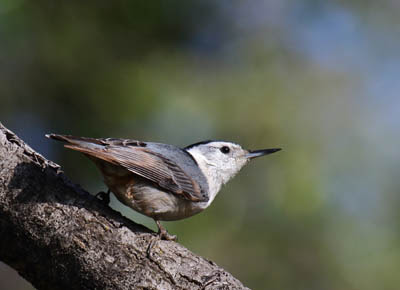 |
| White-breasted Nuthatch. Greg Gillson. |
White-breasted Nuthatch
This small little bird favors black oil sunflower seeds, but also loves all sorts of nuts and peanuts. They like shelled peanuts best.
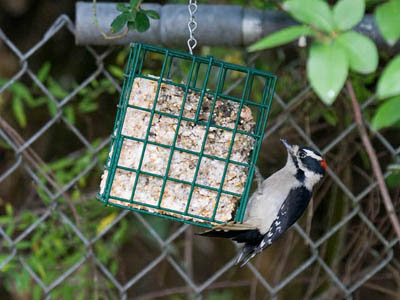 |
| Downy Woodpecker. Greg Gillson. |
Downy Woodpecker
This smallest of North American woodpeckers visits feeders primarily for suet, but will also eat seeds and peanuts. They like peanuts pieces, especially in suet!
 |
| American Crow. Greg Gillson |
American Crow
American Crows are large birds often found in family groups and flocks. They will quickly gobble up all your whole peanuts and carry them away. The key to keeping crows away is not to feed them table scraps of any sort–bread or meat, especially.
 |
| Mourning Dove. Greg Gillson |
Mourning Dove
Doves eat many types of grains and seeds, including peanut pieces.
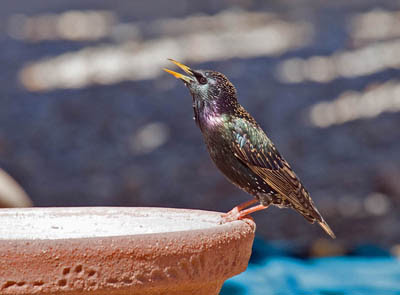 |
| European Starling. Greg Gillson |
European Starling
Starlings often visit your backyard in large flocks. They will eat peanuts, especially in suet. To keep starlings from consuming all your suet in minutes, offer it from an upside-down suet feeder. Starlings can’t hang upside down to reach it, while smaller birds can!
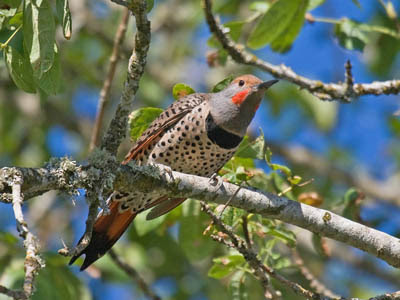 |
| Northern Flicker. Greg Gillson. |
Northern Flicker
These large ant-eating woodpeckers have yellow wing and tail linings in the East, and salmon-colored wing and tail linings in the West. They visit suet feeders and will eat peanuts, too.
Birds that eat peanuts in the East and Southeast
This section lists the birds that eat peanuts that are found primarily in the Eastern and Southeastern parts of the United States.
 |
| Carolina Chickadee |
Carolina Chickadee
This chickadee of the Southeast U.S. loves peanuts! They may prefer them in small pieces.
 |
| Blue Jay |
Blue Jay
Jays love peanuts. They eat them whole, in the shell, as well as shelled. In the fall they may carry off all your whole peanuts to hide and bury them for winter.
 |
| Red-bellied Woodpecker |
Red-bellied Woodpecker
This is a common woodpecker in the East. They come to feeders for suet and nuts, including peanuts.
 |
| Common Grackle |
Common Grackle
These larger blackbirds sometimes appear in larger flocks and may clean out your feeders of many foods, including peanuts. Often they appear seasonally. Put seeds in tube feeders to make it hard for grackles to feed.
 |
| Tufted Titmouse |
Tufted Titmouse
This smaller bird loves peanuts! In fact, they even love them whole, in the shell.
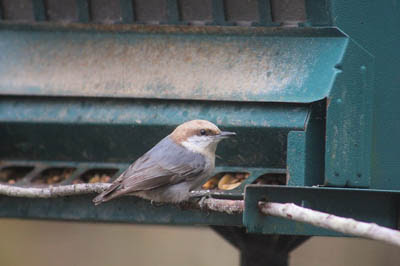 |
| Brown-headed Nuthatch |
Brown-headed Nuthatch
This tiny bird of the Southeastern pine forests loves all sorts of nuts, including shelled peanuts.
 |
| Northern Cardinal |
Northern Cardinal
This bright red bird is common throughout the East. They eat larger seeds and shelled peanuts, too.
Birds that eat peanuts in the West
There are many birds found primarily in the western United States that eat peanuts.
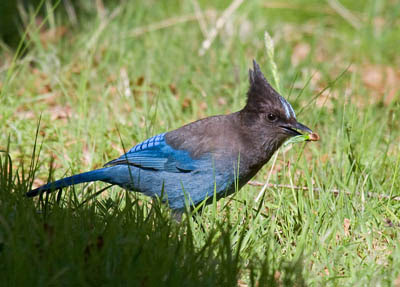 |
| Steller’s Jay. Greg Gillson. |
Steller’s Jay
These jays live in conifer and mixed woods. They love peanuts–any way you serve them! But they are fond of whole peanuts in the shell.
 |
| California Scrub-Jay. Greg Gillson. |
California Scrub-Jay
This is a common jay in oak woodlands and residential areas of the West. They love all nuts, including peanuts in the shell.
In the interior Great Basin resides a similar-looking jay called the Woodhouse’s Scrub-Jay. As with all jays, they eat peanuts.
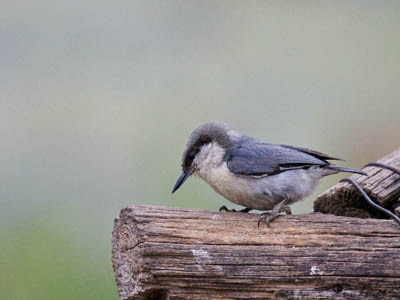 |
| Pygmy Nuthatch. Greg Gillson. |
Pygmy Nuthatch
These tiny birds live in the dry pine forests in western mountains. Like other nuthatches, they love to eat peanut pieces.
 |
| Chestnut-backed Chickadee. Greg Gillson. |
Chestnut-backed Chickadee
These chickadees are found in damp conifer forests of the West. They eat shelled peanuts.
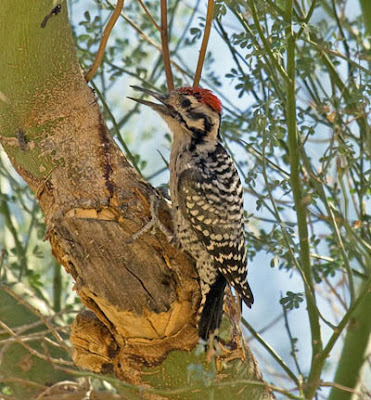 |
| Ladder-backed Woodpecker. Greg Gillson. |
Ladder-backed Woodpecker
Most woodpeckers will eat peanuts. This bird of the desert Southwest is especially known for visiting feeders to eat sunflower seeds, suet, and peanuts.
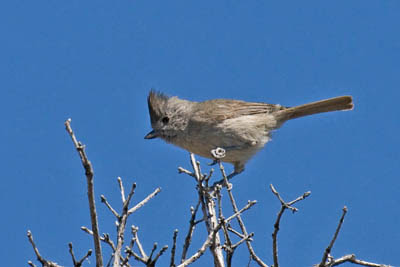 |
| Oak Titmouse. Greg Gillson. |
Oak Titmouse
Like other titmouses, this small bird of Western oak woodlands loves peanuts.
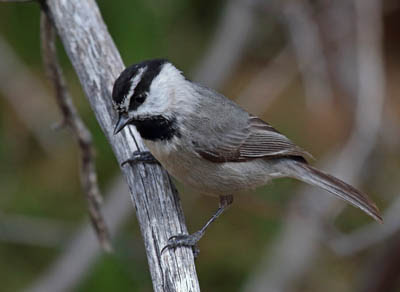 |
| Mountain Chickadee. Greg Gillson. |
Mountain Chickadee
All chickadees love shelled peanuts. This one with the white eyebrow is found primarily in high-elevation conifer forests.
 |
| Clark’s Nutcracker |
Clark’s Nutcracker
This relative of the jays is found at high elevations in the West. If you visit any ski resorts, be sure to bring along some peanuts in the shell for these birds!
Birds that eat peanuts in the North
These peanut-eating birds occur across the northern tier of states from East to West.
 |
| Black-capped Chickadee. Greg Gillson. |
Black-capped Chickadee
These may be the most well-known of the chickadees in the United States. They are common at backyard feeders. They love to eat many kinds of seeds and nuts, including peanuts, shelled and pieces.
 |
| Canada Jay. Greg Gillson. |
Canada Jay
These bold birds often called “camp robbers” love peanuts in the shell. They are found in boreal forests of the north and southward in the higher mountains. They are often found in campgrounds in dense conifer forests.
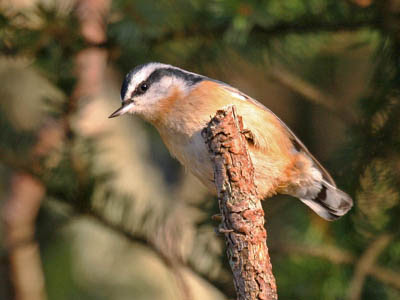 |
| Red-breasted Nuthatch. Greg Gillson. |
Red-breasted Nuthatch
Found in conifer forests in the northern and mountainous parts of the United States. These tiny birds like to eat sunflower seeds and nuts, and also love shelled peanuts.
What kind of peanuts can you feed to different kinds of birds?
You can feed birds whole peanuts or shelled peanuts or peanut pieces. You can feed birds peanuts in suet, peanuts mixed in with other bird seed, and even peanut butter!
Feed birds roasted peanuts, not raw!
Legumes, including beans, peas, soy beans, and peanuts contain trypsin inhibitors.
I’m no expert and may not understand correctly. However, apparently, these foods, in their raw state, can interfere with digestion. This could inhibit nutrients from all foods from nourishing the body when these are eaten.
The answer is to feed birds roasted peanuts. Evidently roasting or cooking solves the problem. One reference for feeding peanuts to bird recommended baking raw peanuts for 15 minutes in the oven at 350℉ to remove the trypsin inhibitors.
Don’t feed birds peanuts that are salted or sugared
We know the deleterious effects of high salt and sugar diets on humans. But the truth is, we don’t know how these additives affect the lives of birds that only naturally live a half dozen to 10 years in the wild.
In fact, certain finches actually seek out salt under certain circumstances (cow salt licks).
You certainly don’t want to harm the birds that feed at your home bird feeder. Thus, don’t make a habit of feeding birds such items as salted potato or corn chips, fried foods, or sugared or salted peanuts.
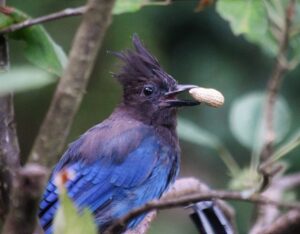
Different ways to feed peanuts to birds
Here are common ways to feed peanuts to birds.
Whole peanuts in the shell
Whole peanuts (roasted, unsalted) in the shell are a favorite of jays and other birds. Most birds, especially in fall, probably take the peanuts away and hide them in a secret cache for later in winter.
Birds that have been reported to especially like whole peanuts in the shell include Blue Jays, Tufted Titmouses, Red-bellied Woodpeckers, Common Grackles, Fish Crows, European Starlings, Steller’s Jays. Not all of these are welcome at bird feeders.
Of course, squirrels love whole peanuts. Some people who feed birds also enjoy feeding squirrels. Other people try to keep the squirrels away from their bird feeders–a difficult task.
Feeding shelled peanuts, halves, and pieces to birds
You can purchase roasted pieces or halves of peanuts out of the shell. Make sure these are unsalted. Many, many birds will eat these, especially birds that normally eat seeds.
But you may be surprised to see insect eating birds eating small crushed pieces of peanuts. These could include Yellow-rumped Warbler, Carolina Wren, and Ruby-crowned Kinglets.
Feeding birds peanuts in suet
Suet is a winter time treat for birds. It is made of rendered fat or lard. Think of it as a big juicy grub for birds.
Many birds love suet. Chickadees, and insect eating birds such as wrens, bushtits, kinglets or warblers will eat suet. Jays and woodpeckers will love it.
There are a myriad varieties of suet. But a favorite flavor with the birds is suet with peanuts.

Feeding birds peanut butter
You can make an warm-weather alternative to suet. Mix together one part peanut butter with 5 parts corn meal. Spread this on tree bark or similar surface. Again. low salt and low sugar is best.
Again, it is the jays, woodpeckers, and nuthatches that love suet and love peanuts, that also love peanut butter.
Mixed bird seed with peanuts
Finally, peanuts can be found in some mixed bird seed varieties.
Peanuts are frequently found in no-mess or waste-free bird seeds. Once they are out of the shell, they are entirely edible.
While not a no-mess variety, this Wagner’s brand Greatest Variety (below) has some peanuts, and over 40% sunflower seeds–the favorite of most seed eating birds.
Wrapping Up
There are several reasons why birds love peanuts, making them a popular choice for bird feeders and a valuable addition to their diet:
High Fat Content: Peanuts are packed with healthy fats, providing birds with a concentrated source of energy. This is especially crucial during cold weather when they need to maintain their body temperature and fuel their activities. The fat content also helps them store reserves for migration or periods of food scarcity.
Protein Power: Peanuts are a good source of protein, essential for building and repairing tissues, feathers, and muscles. This is particularly important for growing chicks and breeding birds.
Palatable Treat: Birds have well-developed senses of taste and smell, and peanuts are simply delicious to them. The combination of the salty flavor and the oily texture is irresistible for many species.
Easy to Eat: Peanuts are relatively easy for most birds to crack open and access the nutritious kernels inside. Their size and shape are suitable for various beak types, making them accessible to a wide range of avian visitors.
Nutritional Variety: Peanunts offer a good balance of other nutrients, including carbohydrates, fiber, vitamins, and minerals. This provides birds with a more complete and nutritious food source compared to some other types of birdseed.
Frequently Asked Questions
Do birds eat peanuts in winter?
Yes, birds absolutely eat peanuts in winter! In fact, their high fat content makes them an even more valuable food source during this colder season. The winter months come with colder temperatures and shorter days, demanding more energy from birds to maintain their body heat and fuel their activities. Peanuts, packed with healthy fats, provide crucial energy reserves for birds facing these challenges. The fat content helps them burn fuel more efficiently and stay warm in the cold.
Peanunts offer more than just energy. They are a good source of protein, essential for repairing tissues, feathers, and muscles, which can be stressed during the winter months. Additionally, they provide valuable vitamins and minerals that support overall bird health and immune function, crucial for fighting off diseases in harsh winter conditions.
Unlike some fruits and insects that become scarce in winter, peanuts remain readily available. They are durable and have a long shelf life, making them a dependable source of food for birds throughout the colder months. This is especially important when natural food sources dwindle, and birds struggle to find enough to eat.
Do cardinals like peanuts?
Absolutely! Northern cardinals are big fans of peanuts, making them a popular choice for attracting these vibrant songbirds to your backyard. Cardinals have well-developed taste buds, and peanuts simply hit the spot for them. The combination of saltiness and nuttiness makes them a highly desirable treat, attracting these beautiful birds to your feeders.
Can you feed wild birds raw peanuts?
The jury is still out on this one. Best to be safe and feed the birds roasted peanuts.
________________________________________________________________________________________
Related Articles:
Get rid of grackles, blackbirds, and starlings from your feeder
What bird seeds do birds really love?
What kind of birds eat cracked corn?
Review: Wagner’s Songbird Supreme mixed bird seed











Robbins also eat peanuts I just discovered. I had no idea.
I didn't know, either! Thanks for sharing your observation.